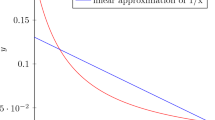Abstract
Given an arbitrary finite nontrivial group, we describe a probabilistic public-key cryptosystem in which the decryption function is chosen to be a suitable epimorphism from the free product of finite Abelian groups onto this finite group. It extends the quadratic residue cryptosystem (based on a homomorphism onto the group of two elements) due to Rabin – Goldwasser – Micali. The security of the cryptosystem relies on the intractability of factoring integers. As an immediate corollary of the main construction, we obtain a more direct proof (based on the Barrington technique) of Sander-Young-Yung result on an encrypted simulation of a boolean circuit of the logarithmic depth.
Similar content being viewed by others
References
Barrington D.M., Straubing H., Therien D. (1990). Non-uniform automata over groups. Inf Comput 132:89–109
Benaloh, J.: Dense probabilistic encryption. In: First annual workshop on selected areas in cryptology, pp. 120–128 (1994)
Coppersmith D., Shparlinski I. (2000). On polynomial approximation of the discrete logarithm and the Diffie-Hellman mapping. J Cryptol 13:339–360
Davenport H. (1980). Multiplicative number theory. Springer, Berlin Heidelberg New York
Do Long Van, Jeyanthi, A., Siromony, R., Subramanian, K.: Public key cryptosystems based on word problems. In: ICOMIDC symposium on mathematics of computations, Ho Chi Minh City, April, 1988
Feigenbaum J., Merritt M. (1991). Open questions, talk abstracts, and summary of discussions. DIMACS series in discrete mathematics and theoretical computer science 2:1–45
Goldwasser, S., Bellare, M.: Lecture notes on cryptography. http://www-cse.ucsd.edu/ users/mihir/papers/gb.html, 2001
Goldwasser S., Micali S. (1984). Probabilistic encryption. J Comput Syst Sci 28:270–299
Grigoriev, D.: Public-key cryptography and invariant theory. arXiv:math.cs.CR/0207080
Grigoriev D., Ponomarenko I. (2005). Homomorphic public-key cryptosystems over groups and rings. Quad Matematica 13:305–326
Ko K.H., Lee S.J., Cheon J.H., Han J.W., Kang J., Park C. (2000). New public-key cryptosystem using braid groups. Lecture Notes Comput Sci 1880:166–183
Magnus W., Karrass A., Solitar D. (1966). Combinatorial group theory: presentations of groups in terms of generators and relations. Interscience Publishers, New York-London-Sydney
Koyama K., Maurer U., Okamoto T., Vanstone S. (1991). New public-key schemes based on elliptic curves over the ring \(\mathbb{Z}_n\). Lecture Notes Comput Sci 576:252–266
Maurer U., Wolf S. (1998). Lower bounds on generic algorithms in groups. Lecture Notes Comput Sci 1403:72–84
Menezes A., van Oorshot P., Vanstone S. (1997). Handbook of applied cryptography. CRC Press, Boca Raton, p. 307
Naccache, D., Stern, J.: A new public key cryptosystem based on higher residues. In: Proceedings of the 5th ACM conference on computer and communication security, pp. 59–66 (1998)
Okamoto T., Uchiyama S. (1998). A new public-key cryptosystem as secure as factoring. Lecture Notes Comput Sci 1403:308–317
Paeng, S.-H., Kwon, D., Ha, K.-C., Kim, J.H.: Improved public key cryptosystem using finite non-Abelian groups. Preprint NSRI, Korea
Paillier P. (1999). Public-Key Cryptosystem Based on Composite Degree Residuosity Classes. Lecture Notes Comput Sci 1592:223–238
Rabin M.O. (1980). Probabilistic algorithms in finite fields. SIAM J Comput 9:273–280
Rappe, D.K.: Algebraisch homomorphe kryptosysteme. Diplomarbeit, Dem Fachbereich Mathematik der Universität Dortmund, Oktober 2000. http://www.matha.mathematik. uni-dortmund.de/~rappe/
Rivest, R.L., Adleman, L., Dertouzos, M.: On data banks and privacy homomorphisms. Foundation of Secure Computation. New York: Academic Press, pp. 169–177 (1978)
Solovay R., Strassen V. (1977). A fast Monte-Carlo test for primality. SIAM J Comput 6:84–85
Sander, T., Young, A., Yung, M.: Non-interactive cryptocomputing for NC1. In: Proceedings of the 40th IEEE Symposium on foundations of Computer Science pp. 554–566 (1999)
Yao, A.: How to generate and exchange secrets. In: Proceedings of the 27th IEEE Symposium on foundations of Computer Science pp. 162–167 (1986)
Author information
Authors and Affiliations
Corresponding author
Additional information
Partially supported by RFFI, grants, 03-01-00349, NSH-2251.2003.1, 02-01-00093.
Rights and permissions
About this article
Cite this article
Grigoriev, D., Ponomarenko, I. Homomorphic Public-Key Cryptosystems and Encrypting Boolean Circuits. AAECC 17, 239–255 (2006). https://doi.org/10.1007/s00200-006-0005-x
Received:
Revised:
Published:
Issue Date:
DOI: https://doi.org/10.1007/s00200-006-0005-x




